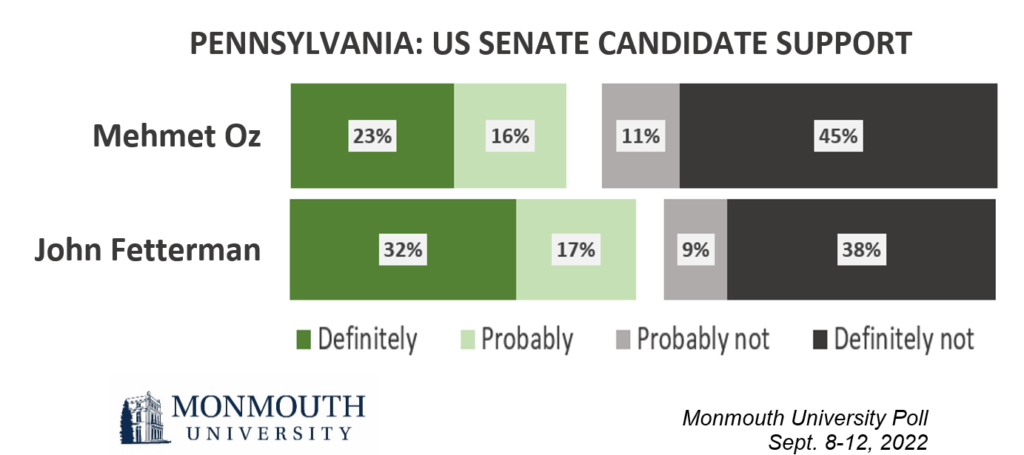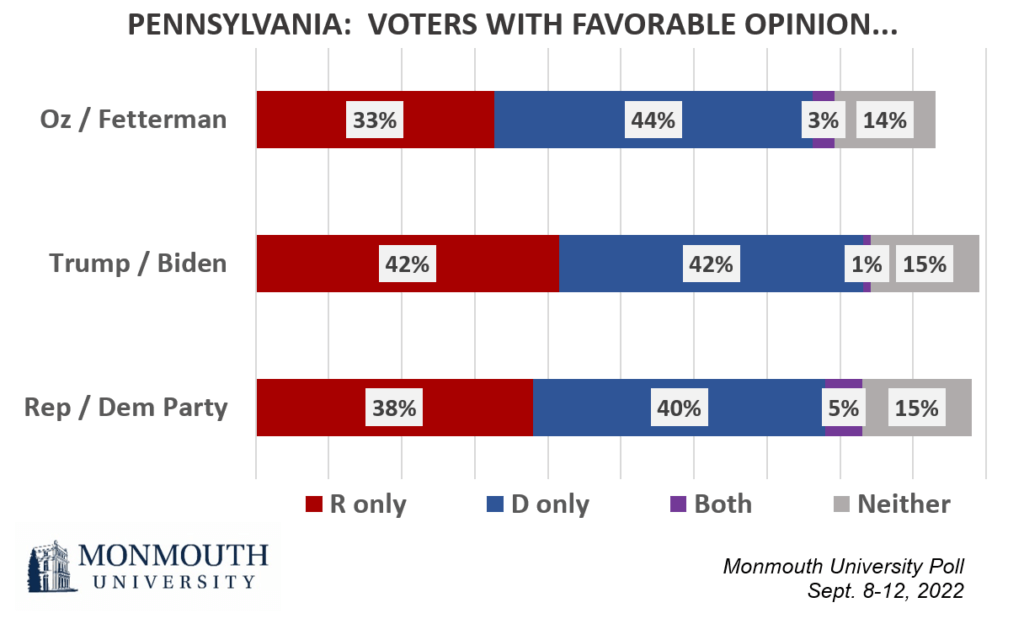West Long Branch, NJ – Democrat John Fetterman is viewed more favorably and is more trusted on key issues than Republican Mehmet Oz, in the race for U.S. Senate in Pennsylvania. Fetterman is also performing a few points stronger than his party in general. The Monmouth (“Mon-muth”) University Poll finds that economic concerns are a bigger factor in voters’ Senate choice than rights and democratic processes, but the latter group is more motivated to turn out at this stage of the campaign.
Fetterman has a positive personal rating of 47% favorable to 42% unfavorable. Just under half of the electorate will either definitely (32%) or probably (17%) vote for him in November. Oz has a net negative personal rating of 36% favorable to 52% unfavorable. About 4 in 10 will either definitely (23%) or probably (16%) vote for him. Slightly more Pennsylvania voters say they definitely will not vote for Oz (45%) than completely rule out Fetterman (38%).

“Fetterman has the edge when you look at basic candidate preferences. Oz will need to overcome his personal negatives or shift the issue picture to stay competitive,” said Patrick Murray, director of the independent Monmouth University Polling Institute.
Bread and butter concerns are driving factors for most Pennsylvania voters. Top issues facing the country according to the commonwealth’s electorate are the economy (30%) and inflation (31%) along with gas prices specifically (7%). Other issues include illegal immigration (14%), abortion (13%), democracy, voting and elections (11%), and crime (9%). When asked directly which set of issues are a bigger factor in their U.S. Senate vote, 52% point to concerns about the economy and cost of living while 38% are more focused on concerns about fundamental rights and the democratic process. Republicans prioritize the economy (72%) and Democrats prioritize rights (59%).
When asked who they trust more on jobs, the economy and cost of living, 41% of voters choose Fetterman and 36% pick Oz. The Democrat also has larger advantages on “defending your values” (43% to 34% for Oz), as well as abortion (44% to 26%) and gun control (40% to 30%). The two candidates run even on being trusted to handle immigration (34% Fetterman to 34% Oz).
“The economy is an issue which could help Oz, but Fetterman currently has enough crossover appeal to negate it. In fact, the poll shows Fetterman is running stronger than the Democratic fundamentals in Pennsylvania would suggest,” said Murray.
Comparing favorability ratings for the two political parties finds them running about even – 45% favorable for the Democratic Party and 43% favorable for the Republican Party. The same is true at the presidential level – 43% have a favorable view of Joe Biden and 43% have a favorable view of Donald Trump. When asked about their preference for party control of Congress, Pennsylvania voters are divided at 47% for the Republicans and 46% for the Democrats.

The poll does not attempt to predict turnout, but various voter history metrics suggest Fetterman is in better position than Oz heading into November. Among those who voted in the 2020 presidential election, just under half definitely (32%) or probably (16%) support the Democrat and 4 in 10 definitely (25%) or probably (16%) support Oz. Among those who voted in last year’s judicial and local races – an election that saw about one-third of registered voters turn out – Fetterman also has an edge (36% definite and 15% probable) over Oz (29% definite and 13% probable).
Oz seems to have a slight, albeit not significant, edge in voter motivation among soft supporters. Among probable supporters of the two candidates, high motivation stands at 56% for those in the Oz camp and 45% among those inclined toward Fetterman. Among those who will definitely vote for Oz, 81% say they are extremely motivated to vote this year. This sentiment stands at 78% among definite Fetterman voters. On the other hand, while more voters are focused on economic concerns than on democratic processes, the latter group is more likely to be extremely motivated than the former this year (72% versus 56%). This dynamic has the potential to help Fetterman with turnout.
“Recent court rulings on abortion and guns have not vaulted those areas to the top of Pennsylvania’s issue list, but they do seem to be motivating a key group of voters who currently back the Democrat. The question is whether they actually show up in November. A shift in this dynamic, particularly if the underlying partisan fundamentals become more of a drag on Fetterman than they are now, can make this a much tighter race,” said Murray.
The Monmouth University Poll was conducted by telephone from September 8 to 12, 2022 with 605 Pennsylvania registered voters. The question results in this release have a margin of error of +/- 4.0 percentage points. The poll was conducted by the Monmouth University Polling Institute in West Long Branch, NJ.
QUESTIONS AND RESULTS
(* Some columns may not add to 100% due to rounding.)
1.Would you say things in the country are going in the right direction, or have they gotten off on the wrong track?
| Sept. 2022 | |
| Right direction | 24% |
| Wrong track | 70% |
| (VOL) Depends | 3% |
| (VOL) Don’t know | 3% |
| (n) | (605) |
2.In your opinion, what are the most important one or two issues facing the country right now? [LIST WAS NOT READ] [Note: Results add to more than 100% because multiple responses were accepted.]
| Sept. 2022 | |
| Economy (general) | 30% |
| Inflation, increasing prices | 31% |
| Gas prices specifically | 7% |
| Health care, health insurance | 6% |
| Abortion | 13% |
| Education, schools | 4% |
| Crime, violence | 9% |
| Gun control, 2nd Amendment | 4% |
| Race, equity | 4% |
| Illegal immigration | 14% |
| Terrorism, national security | 4% |
| Environment, climate change | 7% |
| Covid, pandemic | 1% |
| Democracy, voting, elections | 11% |
| Joe Biden | 6% |
| Donald Trump | 4% |
| Divided country, extremism | 7% |
| Taxes, spending, big government | 2% |
| Poverty, food security | 3% |
| Morality, values | 1% |
| Rights, liberties | 2% |
| Other | 5% |
| Nothing/no answer | 3% |
| (n) | (605) |
3.Would you rather see the Republicans or the Democrats in control of Congress, or doesn’t this matter to you? [CHOICES WERE ROTATED] [If DOES NOT MATTER: If you had to lean one way or the other would you pick the Republicans or the Democrats?]
| Sept. 2022 | |
| Republicans | 40% |
| Not matter, but lean Rep | 7% |
| Democrats | 38% |
| Not matter, but lean Dem | 8% |
| Does not matter, no lean | 5% |
| (VOL) Don’t know | 1% |
| (n) | (605) |
4.Is it very important, somewhat important, or only a little important to have [Republicans/Democrats] in control of Congress? [CHOICE READ FROM Q3]
| Sept. 2022 | |
| Very important | 65% |
| Somewhat important | 18% |
| Only a little important | 8% |
| (VOL) Don’t know / Does not matter who controls Congress (from Q3) | 8% |
| (n) | (605) |
5/6.I am going to read you a list of candidates running for U.S. Senate in Pennsylvania this year. For each one, please tell me if you have definitely heard of them, not sure if you’ve heard of them, or if you’ve definitely not heard of them?
[If DEFINITELY HEARD OF:] For each of the following, please tell me if you have a very favorable, somewhat favorable, somewhat unfavorable, or very unfavorable opinion of them. [NAMES WERE ROTATED]
Very favorable | Somewhat favorable | Somewhat unfavorable | Very unfavorable | Heard of, no opinion (VOL) | Not sure if heard of | Definitely not heard of | (n) | |
| Mehmet Oz, the Republican | 16% | 20% | 12% | 40% | 2% | 1% | 9% | (605) |
| John Fetterman, the Democrat | 29% | 18% | 11% | 31% | 3% | 1% | 7% | (605) |
| Erik Gerhardt, the Libertarian | 0% | 4% | 4% | 1% | 2% | 7% | 82% | (605) |
| Richard Weiss, of the Green Party | 0% | 3% | 2% | 0% | 4% | 7% | 84% | (605) |
| Daniel Wassmer, of the Keystone Party | 0% | 3% | 1% | 1% | 2% | 5% | 89% | (605) |
[QUESTIONS 7 & 8 WERE ROTATED]
7.How likely are you to vote for Mehmet Oz in the election for U.S. Senate – will you definitely vote for him, probably vote for him, probably not vote for him, or definitely not vote for him?
| Sept. 2022 | |
| Definitely | 23% |
| Probably | 16% |
| Probably not | 11% |
| Definitely not | 45% |
| (VOL) Don’t know | 5% |
| (n) | (605) |
8.How likely are you to vote for John Fetterman in the election for U.S. Senate – will you definitely vote for him, probably vote for him, probably not vote for him, or definitely not vote for him?
| Sept. 2022 | |
| Definitely | 32% |
| Probably | 17% |
| Probably not | 9% |
| Definitely not | 38% |
| (VOL) Don’t know | 4% |
| (n) | (605) |
9.Which is more important to you in deciding who to support for Senate this year – concerns about fundamental rights and the democratic process OR concerns about the economy and cost of living? [CHOICES WERE ROTATED]
| Sept. 2022 | |
| Concerns about fundamental rights and the democratic process | 38% |
| Concerns about the economy and cost of living | 52% |
| (VOL) Both equally | 8% |
| (VOL) Don’t know | 2% |
| (n) | (605) |
10.Who do you trust more on [READ ITEM] – Mehmet Oz, John Fetterman, both equally, or neither one? [ITEMS WERE ROTATED] [NAMES WERE ROTATED]
| Mehmet Oz | John Fetterman | Both equally | Neither one | (VOL) Don’t know | (n) | |
| Immigration | 34% | 34% | 4% | 21% | 7% | (605) |
| Gun control | 30% | 40% | 4% | 19% | 7% | (605) |
| Abortion | 26% | 44% | 2% | 21% | 7% | (605) |
| Jobs, the economy and cost of living | 36% | 41% | 4% | 16% | 4% | (605) |
| Defending your values | 34% | 43% | 2% | 17% | 3% | (605) |
[Q11-16 held for future release.]
[QUESTIONS 17 & 18 WERE ROTATED]
17.Is your general impression of the Republican Party very favorable, somewhat favorable, somewhat unfavorable, or very unfavorable?
| Sept. 2022 | |
| Very favorable | 18% |
| Somewhat favorable | 25% |
| Somewhat unfavorable | 20% |
| Very unfavorable | 35% |
| (VOL) Don’t know | 2% |
| (n) | (605) |
18.Is your general impression of the Democratic Party very favorable, somewhat favorable, somewhat unfavorable, or very unfavorable?
| Sept. 2022 | |
| Very favorable | 15% |
| Somewhat favorable | 30% |
| Somewhat unfavorable | 17% |
| Very unfavorable | 36% |
| (VOL) Don’t know | 2% |
| (n) | (605) |
[QUESTIONS 19 & 20 WERE ROTATED]
19.Is your general impression of Donald Trump very favorable, somewhat favorable, somewhat unfavorable, or very unfavorable?
| Sept. 2022 | |
| Very favorable | 20% |
| Somewhat favorable | 23% |
| Somewhat unfavorable | 7% |
| Very unfavorable | 49% |
| (VOL) Don’t know | 1% |
| (n) | (605) |
20.Is your general impression of Joe Biden very favorable, somewhat favorable, somewhat unfavorable, or very unfavorable?
| Sept. 2022 | |
| Very favorable | 16% |
| Somewhat favorable | 27% |
| Somewhat unfavorable | 12% |
| Very unfavorable | 44% |
| (VOL) Don’t know | 1% |
| (n) | (605) |
21.Thinking about Joe Biden’s presidency so far, would you say he is doing a lot better than you thought he would, a little better than you thought, a lot worse than you thought, a little worse than you thought, or has he accomplished about what you thought he would?
| Sept. 2022 | |
| Lot better | 7% |
| Little better | 15% |
| Lot worse | 38% |
| Little worse | 13% |
| About what you thought | 26% |
| (VOL) Don’t know | 2% |
| (n) | (605) |
22.How motivated are you to vote in this year’s election – extremely motivated, very motivated, somewhat motivated, or not motivated?
| Sept. 2022 | |
| Extremely motivated | 64% |
| Very motivated | 21% |
| Somewhat motivated | 10% |
| Not motivated | 4% |
| (VOL) Don’t know | 1% |
| (n) | (605) |
23.Compared to past elections for U.S. Senate and Congress, are you more enthusiastic than usual, less enthusiastic, or about the same as past elections?
| Sept. 2022 | |
| More enthusiastic | 42% |
| Less enthusiastic | 10% |
| About the same | 48% |
| (VOL) Don’t know | 1% |
| (n) | (605) |
24.Do you feel optimistic or pessimistic about the outcome of the upcoming midterm elections? [Is that very or somewhat optimistic/pessimistic?]
| Sept. 2022 | |
| Very optimistic | 20% |
| Somewhat optimistic | 48% |
| Somewhat pessimistic | 20% |
| Very pessimistic | 7% |
| (VOL) Don’t know | 5% |
| (n) | (605) |
25.Looking back at the 2020 presidential election, do you believe Joe Biden won the 2020 election fair and square, or do you believe that he only won it due to voter fraud?
| Sept. 2022 | |
| Fair and square | 62% |
| Due to voter fraud | 32% |
| (VOL) Don’t know | 5% |
| (n) | (605) |
[QUESTIONS 26 & 27 WERE ROTATED]
26.If Joe Biden runs for president in 2024, would you definitely vote for him, probably vote for him, probably not vote for him, or definitely not vote for him?
| Sept. 2022 | |
| Definitely | 17% |
| Probably | 22% |
| Probably not | 10% |
| Definitely not | 48% |
| (VOL) Don’t know | 3% |
| (n) | (605) |
27.If Donald Trump runs for president in 2024, would you definitely vote for him, probably vote for him, probably not vote for him, or definitely not vote for him?
| Sept. 2022 | |
| Definitely | 22% |
| Probably | 18% |
| Probably not | 7% |
| Definitely not | 52% |
| (VOL) Don’t know | 2% |
| (n) | (605) |
METHODOLOGY
The Monmouth University Poll was sponsored and conducted by the Monmouth University Polling Institute from September 8 to 12, 2022 with a probability-based random sample of 605 Pennsylvania voters drawn from a list of active registered voters who participated in at least one general election since 2016 or have newly registered since the 2020 election. This includes 183 contacted by a live interviewer on a landline telephone and 422 contacted by a live interviewer on a cell phone, in English. Monmouth is responsible for all aspects of the survey design, data weighting and analysis. The full sample is weighted for party registration, age, gender, race, education, and region based on state voter registration list information and U.S. Census information (CPS 2018 supplement). Data collection support provided by Braun Research (field) and Aristotle (voter sample). For results based on this sample, one can say with 95% confidence that the error attributable to sampling has a maximum margin of plus or minus 4.0 percentage points (unadjusted for sample design). Sampling error can be larger for sub-groups (see table below). In addition to sampling error, one should bear in mind that question wording and practical difficulties in conducting surveys can introduce error or bias into the findings of opinion polls.
| DEMOGRAPHICS (weighted) |
| REGISTERED VOTERS |
| Party Registration |
| 42% Republican |
| 13% Other/none |
| 45% Democrat |
| Self-Reported Party |
| 34% Republican |
| 34% Independent |
| 32% Democrat |
| 47% Male |
| 53% Female |
| 21% 18-34 |
| 22% 35-49 |
| 29% 50-64 |
| 28% 65+ |
| 84% White, non-Hispanic |
| 10% Black |
| 2% Hispanic |
| 3% Asian/other |
| 62% No degree |
| 38% 4 year degree |
Click on pdf file link below for full methodology and crosstabs by key demographic groups.




